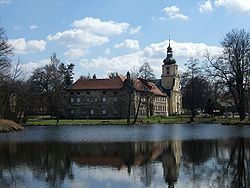Rauden Monastery
| Cistercian Abbey Groß Rauden | |
|---|---|
 Rauden Monastery |
|
| location |
Silesian Voivodeship |
| Coordinates: | 50 ° 11 ′ 41 ″ N , 18 ° 26 ′ 52 ″ E |
| Serial number according to Janauschek |
652 |
| founding year | 1258 |
| Year of dissolution / annulment |
1810 |
| Mother monastery | Jędrzejów Monastery |
| Primary Abbey | Morimond Monastery |
|
Daughter monasteries |
Himmelwitz Monastery (1289) |
The former Cistercian Abbey Groß Rauden ( Polish : Pocysterski Zespół Klasztorno-Pałacowy w Rudach (Wielkich) ) is an Upper Silesian subsidiary of the Jędrzejów Monastery founded on October 21, 1258 . It is located in the village of Rudy ( Groß Rauden ) in the urban and rural community Kuźnia Raciborska ( Ratiborhammer ) in the Silesian Voivodeship in Poland.
history
The monastery, once after its founder, Duke Władysław of Opole , Wladislauskloster called, was later renamed Abbey Rauden. Several villages and the large Boyczow forest belonged to it .
The first abbot of Rauden was Peter I (1258-1274), the first monks came from Jędrzejów in Lesser Poland . Other abbots were Martin I (1456–1471) and Peter III. (1471-1492).
After 1585 the monastery of Rauden was subordinated to the Silesian order province of the Cistercians . Despite the setbacks caused by the Hussite Wars , the Reformation , the Thirty Years' War and the Silesian Wars , the monastery was able to survive economically, not least because of the extensive monastery forests and the industrial and commercial facilities that had been in operation since the 16th century. It experienced a heyday in the 18th century, which was reflected in the founding of the Latin school with boarding school in 1744 and the monastery library with 18,000 printed works. In the middle of the 17th century, in addition to the foundation forests, twelve villages, ironworks, copper hammers and glassworks belonged to the monastery property. The Cistercian monastery in Himmelwitz was founded by Rauden . The convent buildings were rebuilt between 1671 and 1680.
With the secularization of 1810, the monastery and its possessions became state property. The last abbot was Bernhard Galbiers, who ruled from 1798–1810. The Latin school was closed in 1816.
The Rauden monastery and its property were sold to the Landgraviate of Hessen-Kassel in 1812 . In 1820, however, Rauden changed hands again. Landgrave Victor Amadeus of Hessen-Rothenburg received the complex as compensation for other land losses when the demarcation changed in 1815. In 1821 raised by the Prussian King to Duke of Ratibor , he expanded it into a residential palace. The monastery church was rededicated to the parish church of Rauden. After his death in 1834, the inheritance and title passed to Viktor von Hohenlohe-Waldenburg-Schillingfürst .
The monastery building and the church were badly damaged during the Second World War. The monastery building remained in neglect until a few years ago. Extensive renovation work has been taking place since 1998. Today the former Cistercian monastery Rauden belongs to the diocese of Gleiwitz , which in 2009 ran an educational facility with several conference rooms and overnight accommodations in the monastery buildings. The new Diocesan Museum of the Diocese of Gliwice will have its seat there.
To the north of the monastery there is an English landscape park from around 1849.
Monastery church
The first monastery church in the early Gothic style was completed in 1300. Between 1696 and 1716 the church was renovated in the Baroque style. In 1724 an octagonal tower with a hood was built in front of the main entrance. The facade was redesigned in baroque style by 1790. The church burned down during the Second World War in 1945. In the years 1947–1950 the parish church was restored, based on the Gothic state from the 13th century.
In the church there is a Baroque Lady Chapel, built between 1723 and 1726, with the image of the "Mother of God von Rauden". The image, which has been changed several times, probably comes from the 15th century. In 1990 it was restored.
Monastery building
The two-story, square enclosure building with cloister and garden was built between 1671 and 1680 on the remains of a previous Gothic building.
The abbot's residence adjoins the cloister building in the north. The building, erected in 1730, was redesigned in Baroque style between 1901 and 1939. There is a tower at one corner of the house.
There is an exhibition on the history of the Cistercian order in the monastery building.
literature
- Heinrich Grüger: Rauden, Cistercian Abbey . In: Yearbook of the Silesian Friedrich Wilhelm University in Breslau 22 (1981), pp. 33–49.
- August Potthast : History of the former Cistercian Abbey Rauden in Upper Silesia . Ceremony for the sixth secular celebration of its foundation, Leobschütz. Farmer. 1858. VIII, 308 pp.
- Georg Hyckel : Raudens monastery last days . In: Ratiborer Heimatbote 1933.
- Alfons Nowack : The priests of the Cistercian Abbey Rauden OS . 1682 - 1810. (1856) 106 life sketches based on the pen's handwritten catalog. Wroclaw 1935.
- Adolf Gessner: Rauden Abbey in Upper Silesia, sources and representations on Silesian history . Published by the Historical Commission for Silesia , Holzner-Verlag, Kitzingen-Main 1952.
- Wolfgang F. Reddig: The Cistercian Abbey Rauden . In: Ulrich Knefelkamp, Wolfgang F. Reddig (Hrsg.): Monasteries and landscapes, Cistercians west and east of the Oder . Accompanying volume for the exhibition of the European University Viadrina, Frankfurt / O. 1999, ISBN 3-931278-19-0 , pp. 175-176.
photos
Web links
- Educational institution of the Diocese of Gliwice in Rauden
- Rauden, an Upper Silesian cultural site in the forest




